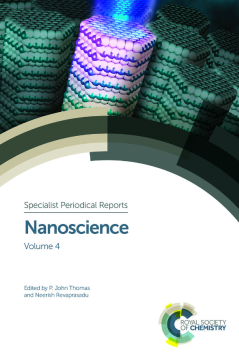
Additional Information
Book Details
Abstract
The field of nanoscience continues to grow at an impressive rate and, with such a vast landscape of material, careful distillation of the most important discoveries will help researchers find the key information they require. Nanoscience Volume 4 provides a critical and comprehensive assessment of the most recent research and opinion from across the globe. Coverage includes diverse topics such as 2D nanomaterials, quantum dot solar cells and core nanoparticles for drug delivery applications. Anyone practising in any nano-allied field, or wishing to enter the nano-world will benefit from this resource, presenting the current thought and applications of nanoscience.
Table of Contents
| Section Title | Page | Action | Price |
|---|---|---|---|
| Cover | Cover | ||
| Contents | xiii | ||
| Preface | v | ||
| Author biographies | vi | ||
| Role of ligands in the synthesis of bi- and multi-metallic nanocrystals | 1 | ||
| 1 Introduction | 1 | ||
| 2 Ligand effects | 4 | ||
| 3 Influence of coordination ligands on metal precursors | 8 | ||
| 4 Influence of linear surfactants | 12 | ||
| 5 Influence of macrocyclic surfactants | 21 | ||
| 6 Conclusion | 25 | ||
| References | 26 | ||
| Recent highlights in advanced transmission electron microscopy techniques: applications to nanomaterials | 29 | ||
| 1 Introduction to aberration corrected S/TEM | 29 | ||
| 2 AC-TEM imaging of carbon nanomaterials and related hybrid structures | 31 | ||
| 3 Nanoparticles | 34 | ||
| 4 1D Nanomaterials | 37 | ||
| 5 2D Materials | 39 | ||
| 6 Beam sensitive materials | 42 | ||
| 7 3D Techniques | 43 | ||
| 8 In situ electron microscopy | 45 | ||
| 9 Conclusions | 49 | ||
| Acknowledgments | 50 | ||
| References | 50 | ||
| Gold fabricated core–shell nanoparticles as innovative cancer\r\ntherapeutic strategies to improve drug delivery | 57 | ||
| 1 Introduction to cancer therapeutics | 57 | ||
| 2 Gold based core-shell nanoparticles for cancer drug delivery | 59 | ||
| 3 Nano-drug formulations for cancer drug delivery | 66 | ||
| 4 Pharmaceutical formulation and drug development | 69 | ||
| 5 Future perspectives for gold based core-shell nanoparticles | 71 | ||
| Acknowledgments | 71 | ||
| References | 71 | ||
| Supramolecular chemistry of AIE-active tetraphenylethylene \r\nluminophores | 75 | ||
| 1 Introduction | 75 | ||
| 2 AIE-active TPE luminogen | 76 | ||
| 3 General syntheses and reactivity | 78 | ||
| 4 Self-assembly of PDI, NDI and porphyrin bearing TPE moieties | 78 | ||
| 5 TPE moieties bearing macromolecules | 85 | ||
| 6 Chiral assembly | 89 | ||
| 7 Applications | 95 | ||
| Acknowledgments | 102 | ||
| References | 102 | ||
| A review of two-dimensional nanomaterials\r\n beyond graphene | 108 | ||
| 1 Introduction | 108 | ||
| 2 Two-dimensional (2D) nanomaterials | 109 | ||
| 3 Heterostructures | 128 | ||
| 4 Conclusions and outlook | 130 | ||
| Notes and references | 130 | ||
| Colloidal quantum dots solar cells | 142 | ||
| 1 Introduction, historical background of colloidal quantum dots | 142 | ||
| 2 Semiconductors: dimensionality and quantum confined structures | 143 | ||
| 3 Optoelectronic properties of CQDs | 146 | ||
| 4 CQD chemical properties | 149 | ||
| 5 Doped CQDs | 153 | ||
| 6 CQD synthesis | 154 | ||
| 7 Thin film fabrication | 156 | ||
| 8 Electrical properties of colloidal quantum dots | 158 | ||
| 9 Solar cell device physics and performance | 161 | ||
| 10 Conclusion and perspective | 164 | ||
| References | 164 | ||
| The role of ligands in mediating charge transport in \r\nnanocrystalline medium | 169 | ||
| 1 Introduction | 169 | ||
| 2 Coulomb blockade and single electron tunnelling | 169 | ||
| 3 Charge transport in arrays of nanocrystals | 172 | ||
| 4 Ligands and charge transport | 175 | ||
| References | 182 |
